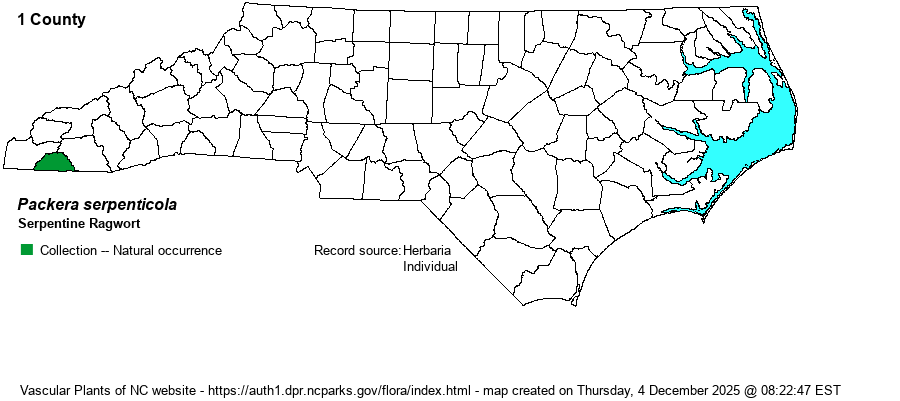| Author | Boufford, Kartesz, Shi, & Zhou | |
| Distribution | Known only from Clay County.
This recently-described species is endemic to Buck Creek Barrens in Clay County. As such, the species should be elevated to State Endangered in the near future. | |
| Abundance | Known from just one location, but within this site is known from 8-10 sub-sites. The population consists of over 10,000 plants and is not under immediate threat. As this is its only location, it should be Federally listed at some point in the future. At the state level, it is listed as Threatened. | |
| Habitat | Pine barrens (mainly Pinus rigida) on serpentine rock, in various settings, such as roadbanks, glades, and open grassy slopes. |
| Phenology | Flowering and fruiting May-June. | |
| Identification | This species is essentially identical to Golden Ragwort (P. aurea), but the leaves (including the petioles) and stems are covered with dense, woolly hairs, and the leaves are only 1-2.5 inches wide (vs. 2-4 inches wide in P. aurea). In addition, Golden Ragwort is a wetland plant of seepages, swampy ground, and other wet places; whereas this species prefers dry to mesic grassy barrens in very high pH soil. | |
| Taxonomic Comments | Formerly hidden within P. aurea, and later included within P. plattensis, but it was obvious that this taxon did not comfortably fit within either species. As a result, it was described as new to science in 2014 by David Boufford et al.
| |
| Other Common Name(s) | Buck Creek Ragwort | |
| State Rank | S1 | |
| Global Rank | G1 | |
| State Status | T | |
| US Status | | |
| USACE-agcp | | |
| USACE-emp | | |

